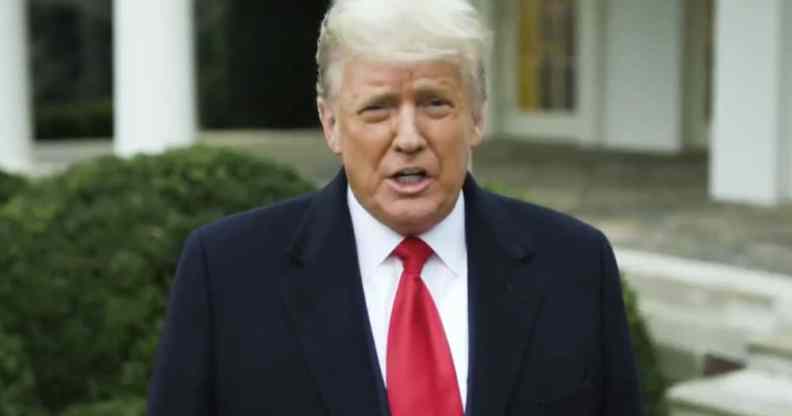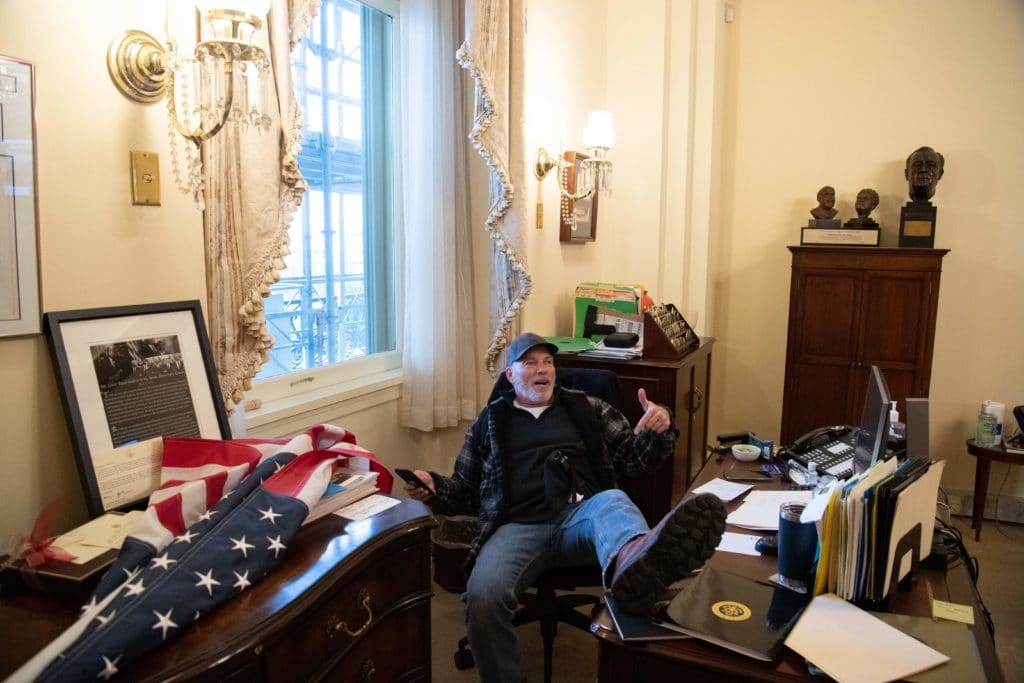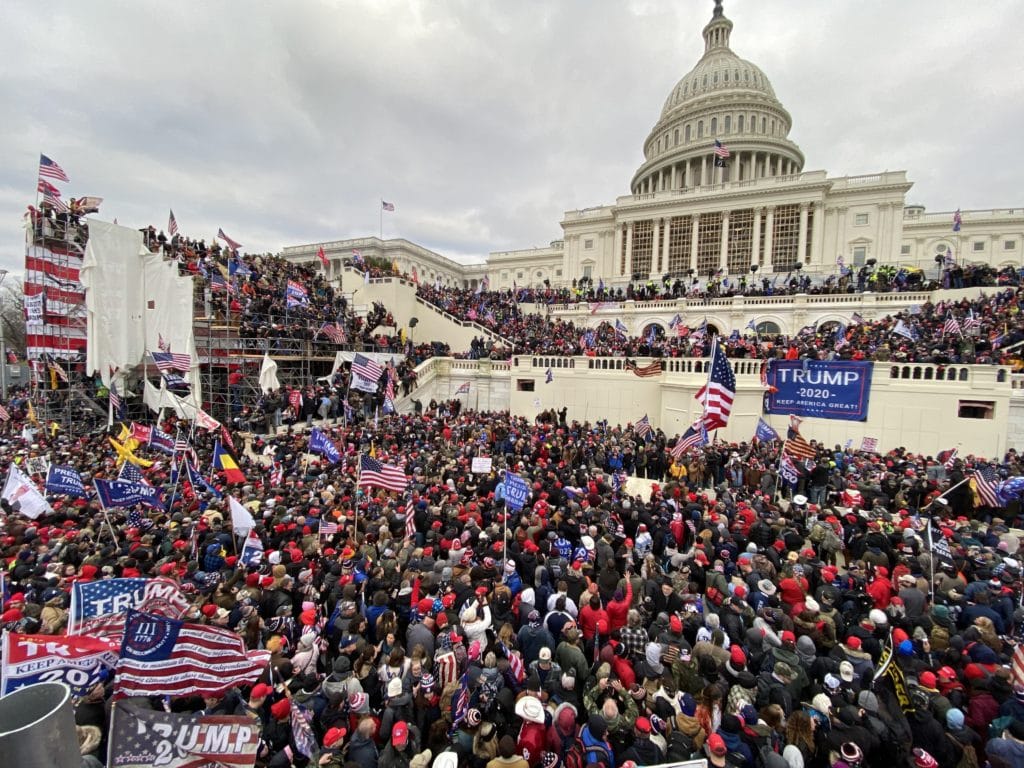Donald Trump’s pitiful Twitter ban highlights the double standard between white supremacy and calling out transphobia

Donald Trump addresses social media followers in a video uploaded in the throes of the Capitol riots. (Screen capture via Twitter)
LGBT+ Twitter users, between being engulfed by rage and recoiling with horror, quickly pointed out Wednesday evening (6 January) the stark difference between the social network’s ban of Donald Trump during the Capitol riots and its treatment of LGBT+ users.
After tepidly tagging warnings on some tweets, Twitter meted the US president a brief ban from his account with an ultimatum – delete the messages it said broke its “civic integrity policy” or face a longer suspension. It made clear it would escalate its enforcement efforts and ban Trump permanently if he continued to break the rules.
The 12-hour suspension was the first penalty the leader had faced in his four-year presidency and was seen by scores of users as not severe enough for what his tweets did – stoke and encourage the violent white supremacy Capitol riots.
LGBT+ users sought to stress this by highlighting their own experiences with Twitter temporarily banning their account for what, they said, were often desultory tweets about trans topics or battling against anti-trans trolls.
They criticised the sluggishness of the social media platform’s response to Trump’s actions that day, as well as the months he spent stoking the anger of his supporters with false claims of election fraud and refused for hours to condemn the unruly rioters. Giving him a “slap on the wrist” for his actions in the end.
Can't post the shut the FUCK up terf memes but trump can invite a coup
Ok…
— Guess I'll Simp Abby (@BeesHatePigs) January 6, 2021
twitter when I tell a terf to shut the fuck up: your violence is unacceptable and you won’t be able to appeal your suspension
twitter when trump promotes legitimate violence against the nation: ok lil buddy you’re gonna have a time out so you can think about what you said— Clarisse (@Phinmeister) January 7, 2021
twitter suspends queer and trans people for seemingly no reason en mass but can’t grow a spine and suspend trump after he has spent the past two months inciting violence
grow a fucking spine @jack— rosemary (@theyby__) January 7, 2021
I can't believe I got a temporary Twitter ban for saying I hoped a TERF got diarrhoea but Trump has planned and directed an actual coup attempt on this hell site and is still allowed to tweet like Karen on crack #CapitolHill— Anna (@AnnaSels) January 6, 2021
While other users derided the platform for locking Trump from his account for 12 hours while some of its most vulnerable users – trans youth, sex workers, among others – face harsher penalties for lesser actions.
Twitter can lock trumps acc with a slap on the wrist but suspends innocent trans kids daily for defending themselves from terfs…
— rose (@carlislediIf) January 7, 2021
Black trans women posting BLM have gotten three times worse punishment from the Twitter company than Donald Trump is getting for trying to coup with a white mob.— ????? (@charmsprainktty) January 7, 2021
Donald Trump, egging on riots laying siege to the Capitol, was slapped with a Twitter ban. Too little, too late, critics say
A pro-Trump gathering outside Capitol Hill, Washington DC, where lawmakers were ratifying the Electoral College vote to confirm president-elect Joe Biden’s victory, soon exploded into chaos Wednesday afternoon.
Many of the MAGA hat-wearing and Confederate flag-touting rioters had come to the Capitol at the president’s behest after attending a rally earlier that day at the White House. “We will never concede,” Trump spouted, inciting the loyalists to break into the Capitol to try to prevent the certification ceremony.
The violence of an extremist mob tore through the grand walls of the Capitol complex, scaling walls, looting priceless artwork, smashing windows, posing on the dais and placing their boots atop members of the House’s desks in a weeks-long plot loosely organised on social media.

Richard Barnett, a supporter of US president Donald Trump sits inside the office of US speaker of the House Nancy Pelosi. (SAUL LOEB/AFP via Getty Images)
The far-right insurgents, acting on and egged by the president’s encouragement, stormed the building in what became a stress test for American democracy itself.
Trump, meanwhile, took to Twitter. His first response urged his supporters to “stay peaceful”.
After some of his tweets were tagged with warnings, or the ability for users to engage completely removed altogether, Twitter finally locked the president out of his account Wednesday evening after he openly condoned the occupation.
His tweet appeared to prop up the white supremacists as “patriots”, as well as spew baseless election tampering claims, in what was a vastly lukewarm response from the outgoing president to the first time in modern history Capitol Hill had been sieged and a woman inside slain.

Violent rioters gather outside the Capitol building in Washington DC. (Tayfun Coskun/Anadolu Agency via Getty Images)
Twitter first attached a warning to his final tweet, noting it was a disputed claim, before removing it. In a follow-up message, Twitter confirmed it had suspended Trump’s Twitter feed for 12 hours and threatened to suspend his account if he did not delete the tweet.
It was a simmering saga, but one which drew intense criticism against Twitter for what was seen as a too little too late response. Trump had issued various perfunctory messages throughout the three-hour-long occupation that did little to discourage the violence while repeating his played-out track of election fraud.
White House officials, shaken by the hours-long brutality, began handing in resignation letters – further isolating the president.
Some of his most loyal and longest-serving aides quit, many attributing their defection to the horror of the day and Trump’s own provocative response, worrying he was not forceful enough when he did eventually call for order.
Only furthering fury against Twitter, Facebook CEO Mark Zuckerberg announced Thursday (7 January): “We are extending the block we have placed on his Facebook and Instagram accounts indefinitely and for at least the next two weeks until the peaceful transition of power is complete.”

